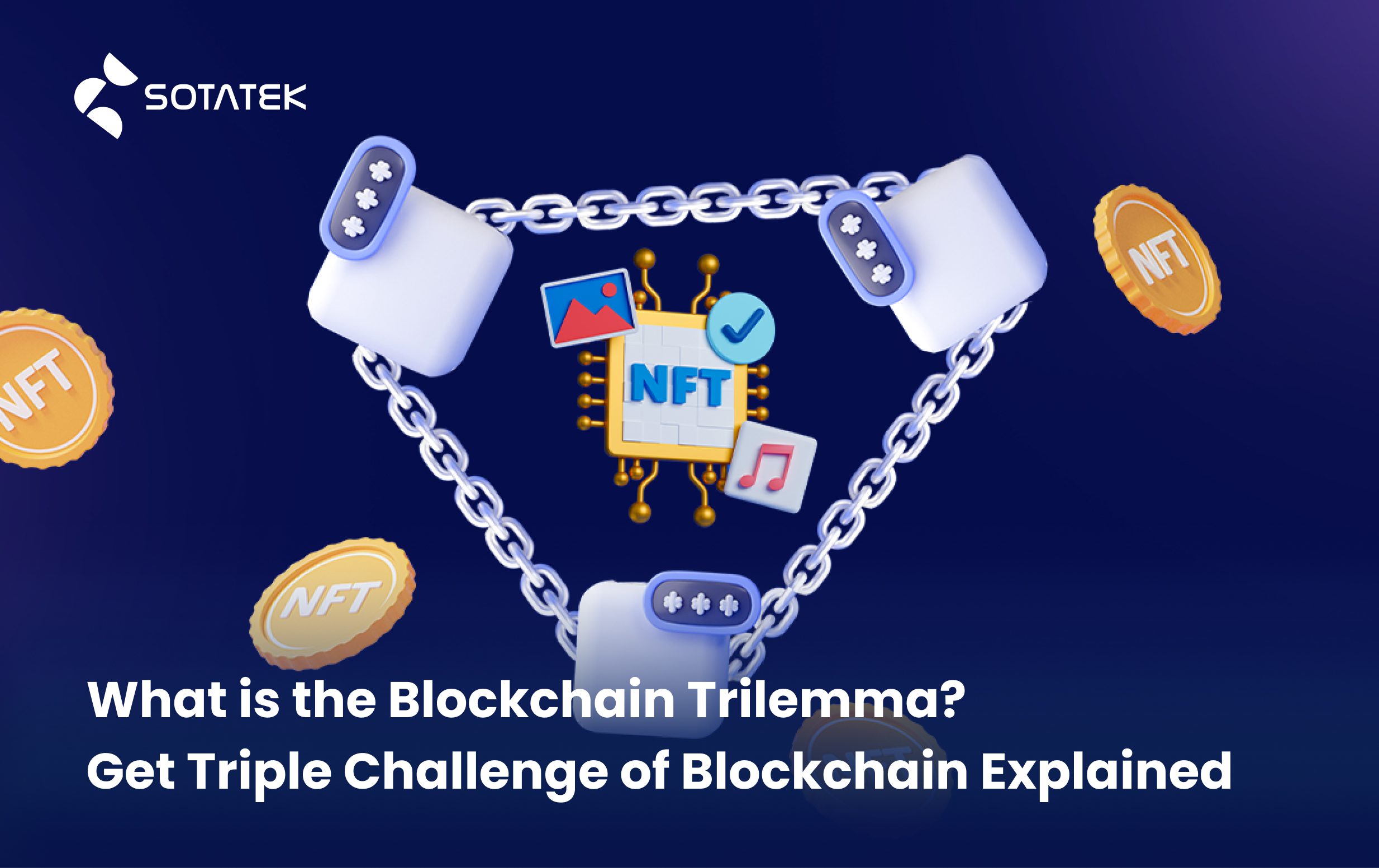In the dynamic landscape of blockchain technology, the Blockchain Trilemma stands as a formidable obstacle, presenting a delicate balancing act between scalability, security, and decentralization. This threefold challenge underscores the inherent trade-offs faced by blockchain developers and enthusiasts. Achieving optimal scalability while maintaining robust security measures and preserving decentralization is a complex puzzle that requires careful consideration.
In this blog, we will explore what Blockchain Trilemma is, its impact on Blockchain Technology as well as some potential solutions for this challenge.
1. What is Blockchain Trilemma?
The Blockchain Trilemma, also known as The Blockchain Impossible Trinity, describes the limitations of blockchain technology. In the most desirable circumstance, Blockchain Technology is expected to achieve: Security, Decentralization, and Scalability. These three pillar qualities together define the performance and reliability of a blockchain network. But it's difficult for blockchains to optimize all three of these properties at the same time. An increase in one attribute often leads to a weakening of another attribute. So, it's called the Blockchain Trilemma.

What is Blockchain Trilemma
What is Decentralization?
Decentralization refers to the distribution of control and decision-making across a network of nodes (computers) rather than being concentrated in a single authority. Everyone has access to the same data. If anyone tries to cheat the system by changing the records in their favor, then the rest of the participants will reject the faulty data.
What is Security?
In the blockchain systems, ensuring security is of utmost importance. It involves implementing measures to thwart unauthorized access and prevent fraudulent activities within the network. Blockchain technology achieves this through the use of robust encryption, public-key cryptography, and consensus algorithms.
What is Scalability?
Scalability refers to the system's capability to manage a growing volume of transactions without compromising its network efficiency. This becomes particularly crucial when blockchain technology needs to cater to a substantial user base, potentially reaching billions of people. Achieving scalability in blockchain is challenging due to the inherent trade-offs with decentralization and security. While decentralization is a core principle of blockchain systems, and security is paramount for ensuring integrity, emphasizing these aspects can pose limitations on scalability.
2. Why does the Blockchain Trilemma exist? How does it affect Blockchain?
The essence of Blockchain Trilemma lies in the complex trade-offs between decentralization, security, and scalability. Achieving optimal levels of these three properties simultaneously poses a significant challenge, requiring careful consideration of their dependence on each other.
Consider this: the desire for enhanced scale and speed might prompt a reduction in the number of participants contributing to the network. However, this move towards scalability could result in decreased decentralization, consolidating control in the hands of fewer participants. Simultaneously, it might expose the system to security risks, given the higher vulnerability to attacks with a reduced number of participants.
So, here lies in the Trilemma: “When one attribute increases, this often weakens another”.
3. Are there any solutions for this problem?
a. Sharding
Sharding, derived from distributed databases, serves as a prevalent scaling solution for Layer-1. The underlying concept is "divide and conquer," where the blockchain network is fragmented into smaller shards. Each shard is capable of processing a subset of the total transactions, preventing an undue burden on a single central entity.
b. Different consensus mechanism
The trilemma challenge in the Bitcoin network arises due to the security measures implemented by Proof of Work (PoW). While PoW ensures a secure system through miners, cryptographic algorithms, and extensive decentralized computing power, it comes at the cost of speed. Addressing the trilemma involves exploring alternative consensus mechanisms, such as Ethereum's transition from PoW to Proof of Stake (PoS).

Addressing the trilemma involves exploring alternative consensus mechanisms
c. Layer-2 solutions
Both sharding and alternative consensus mechanisms fall under the category of Layer-1 solutions, aiming to reshape the foundational design of the underlying network. However, some developers addressing the trilemma are exploring Layer 2 solutions that build upon the existing network structure. Examples include sidechains and state channels, which facilitate off-chain transactions to alleviate pressure and enhance speed. Sidechains are independent blockchains connected to the main chain, while state channels leverage smart contracts to reduce the load on the main chain.
Related: Zk Rollups vs Optimistic Rollups: Which Layer 2 Solution is better?
4. Final thoughts
Addressing the intricacies of the Blockchain Trilemma demands a flexible and intelligent combination of many different methods and mechanisms. A single approach cannot simultaneously resolve all three challenges. Rather, a sophisticated, innovative, and carefully crafted system is essential to uphold a balance between decentralization, security, and scalability.



